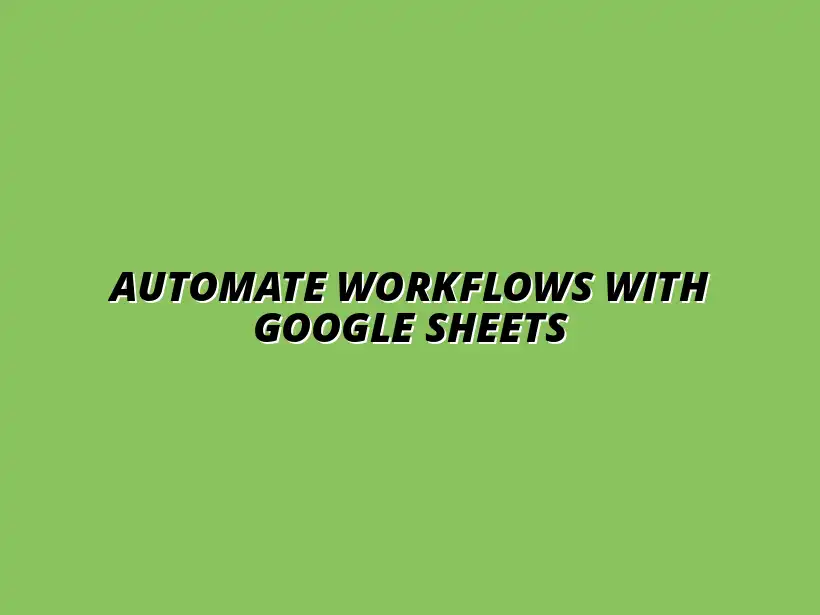
Automate Workflows with Google Sheets
Understanding Automated Workflows in Google Sheets
In today's fast-paced world, automated workflows are essential for managing repetitive tasks efficiently. By utilizing tools like Google Sheets, we can automate various processes, saving time and reducing the likelihood of errors. Understanding how these workflows operate lays a strong foundation for implementing automation in our daily tasks.
Automated workflows streamline tasks by minimizing manual input and allowing for quicker data processing. This not only enhances productivity but also increases focus on more critical activities. The ability to automate routine tasks empowers users to concentrate on strategic goals rather than getting bogged down by mundane chores. To learn more about streamlining data entry, check out this helpful guide on streamlining data entry with Google Sheets.
The Importance of Automation in Streamlining Tasks
Automation plays a crucial role in modern work environments by optimizing processes and improving efficiency. With automated workflows, tasks that once consumed hours can now be completed in minutes. This shift results in better resource allocation and greater job satisfaction as team members can engage in more meaningful work.
- Increased Productivity: Automation allows for faster completion of tasks.
- Error Reduction: By automating data entry, we can minimize human mistakes.
- Scalability: Automated workflows can easily adapt to increased workloads.
Moreover, automation enhances collaboration among team members. When tasks are automated, everyone is on the same page, making it easier to track progress and share updates. This fosters a culture of teamwork and innovation, which is vital for any organization's success!
How Google Sheets Facilitates Workflow Automation
Google Sheets offers a powerful platform for automating workflows, thanks to its built-in functions and integration capabilities. Formulas, along with features like “Google Apps Script,” enable users to create custom automation solutions. These tools make it easy to manage data and automate repetitive tasks effectively. Learn how to automate tasks with Google Sheets to boost your efficiency.
- Real-time Collaboration: Multiple users can work simultaneously on the same document.
- Accessibility: Google Sheets is cloud-based, allowing access from anywhere.
- Integration: It connects with other Google services and third-party applications.
Additionally, Google Sheets allows for easy data visualization through charts and graphs. This is extremely helpful in analyzing results from automated workflows and making informed decisions quickly. For effective data visualization techniques, explore this resource on effective data visualization in Sheets. Overall, the versatility of Google Sheets makes it an excellent choice for anyone looking to embrace automation in their workflows!
Utilizing Templates for Effective Automated Workflows
Templates serve as a fantastic starting point for setting up automated workflows in Google Sheets. They provide a structured format that can be easily customized to fit specific needs. By using templates, we can quickly implement automation without starting from scratch!
With a variety of templates available, users can find options tailored for different scenarios. Whether you're tracking expenses, managing projects, or collecting data, there’s a template out there for you. Utilizing these templates can significantly cut down on setup time and ensure a more efficient workflow. Discover how to streamline your workflow with Google Sheets templates.
Types of Templates Available for Google Sheets
Google Sheets offers numerous templates that can cater to various business needs. These templates can be broadly classified into two categories: pre-built templates and customizable templates. Each type has its unique benefits, allowing users to choose what best suits their workflow requirements.
- Pre-built Templates: Ready to use with minimal customization needed.
- Customizable Templates: Designed to adapt and meet specific needs.
By exploring these options, you can leverage the power of templates to enhance your productivity. The right template can serve as a foundation for creating a smooth automated workflow, saving you valuable time and effort!
Pre-built Templates for Common Use Cases
Pre-built templates are often developed based on common scenarios, making them easy to use for most individuals. Some popular examples include:
- Budget Tracking
- Project Management
- Sales Pipeline Management
These templates come equipped with formulas and formatting that help streamline processes. They are excellent for users looking for quick solutions to common tasks without needing to create complex setups.
Customizable Templates for Specific Needs
Customizable templates provide the flexibility to tailor a workflow to meet specific requirements. Users can modify fields, formulas, and layouts based on their workflow demands. This adaptability ensures that every aspect of the template aligns with the user’s objectives!
- Adjusting data fields and categories
- Incorporating advanced functions for specific calculations
- Designing layout and aesthetics to match branding
Such customization paves the way for effective automation that fits like a glove. The ability to design templates according to unique needs significantly enhances the overall efficiency of automated workflows. Learn more about automating Google Sheets reports with this helpful guide: Automate Google Sheets Reports Easily.
Benefits of Using Templates for Automated Workflows
Using templates for automated workflows presents several key benefits. They not only simplify the setup process but also ensure consistency across tasks. This is especially important in environments where teams need to collaborate and share information seamlessly.
- Time-Saving: Templates reduce the time taken to design workflows from the ground up.
- Standardization: They establish consistent practices across various tasks.
By implementing templates, we can focus on refining workflows rather than getting lost in the details. Ultimately, templates allow for a smoother transition into automation while maintaining high standards of productivity!
Time-Saving Advantages of Pre-Designed Templates
Pre-designed templates are fantastic for saving time and effort. With these templates, the groundwork is already laid out, allowing users to jump right into their tasks. This is particularly beneficial for those who are new to Google Sheets or automation. Discover more ways to automate tasks using Google Sheets.
- Quick setup with little to no customization
- Less learning curve for beginners
- Immediate usability for common tasks
By utilizing these templates, I can get straight to work and accomplish my goals faster. It’s all about making the most of our time, and pre-designed templates help us achieve just that!
Enhancing Consistency and Accuracy in Data Management
The use of templates enhances consistency and accuracy in data management significantly. When creating workflows, having a standard template helps ensure that all necessary information is captured uniformly. This minimizes discrepancies and errors that often arise in processes where manual input is involved. For Google Sheets shortcuts to enhance analysis, see Google Sheets Shortcuts for Analysis.
- Consistent data entry formats
- Uniform calculations and functions
- Standardized reporting structures
Maintaining consistency in data management becomes much easier with templates in place. It also ensures everyone on the team is on the same page, making collaboration more effective and smooth!
Setting Up Automated Workflows with Templates in Google Sheets
Setting up automated workflows using templates in Google Sheets is a straightforward process. With a clear understanding of your needs and the right template, you can create efficient workflows in no time. Let's dive into the steps involved in implementing templates for automation!
We will explore how to select the right template, customize it to fit your workflow needs, and connect it with other tools. This comprehensive approach will ensure you maximize the benefits of automation in your tasks.
FAQ: Common Queries About Using Templates for Automated Workflows
When it comes to using templates for automated workflows in Google Sheets, there are often many questions that arise. Understanding these frequently asked questions can help you navigate the world of automation more effectively. Let’s dive into some common queries and their answers!
One of the most common questions is about the types of workflows that can be automated. With the right templates, you can automate tasks ranging from simple data entry to complex project management processes. By knowing what’s possible, you can better leverage the power of Google Sheets.
What Types of Workflows Can Be Automated Using Google Sheets?
Google Sheets is incredibly versatile, allowing for a wide range of workflows to be automated. Here are some examples of workflows that can benefit from automation:
- Data collection and analysis
- Expense tracking and budget management
- Sales reporting and forecasting
- Project timelines and task management
- Inventory management and tracking
Using templates for these workflows not only automates repetitive tasks but also enhances efficiency and accuracy in data handling. By selecting the right template, you can save time and reduce manual errors!
Are There Free Templates Available for Automated Workflows?
Absolutely! There are numerous free templates available that you can use right away. Google Sheets itself offers a variety of built-in templates that cater to different needs. Additionally, websites and communities often share free templates designed for automation.
These free templates cover various categories, including:
- Budget planners
- Sales trackers
- Expense reports
- Project planners
- Event planners
By utilizing these free resources, you can kickstart your automation journey without any upfront costs!
How Can I Share My Automated Workflow Template with Others?
Sharing your automated workflow templates in Google Sheets is straightforward and user-friendly. Here's how to do it:
- Open the Google Sheets template you want to share.
- Click on the “Share” button in the top right corner.
- Enter the email addresses of the people you want to share it with.
- Choose the level of access (Viewer, Commenter, or Editor).
- Click “Send” to share the template.
With this easy sharing feature, you can collaborate with teammates, friends, or anyone who may benefit from your automated workflow templates!
Real-World Applications of Automated Workflows in Google Sheets
Automated workflows in Google Sheets have real-world implications and applications that can significantly enhance productivity. Numerous businesses and individuals have successfully implemented these workflows to streamline their processes.
By examining case studies, we can see how companies utilize automated workflows to meet specific needs and improve efficiency, making them more competitive in their respective industries!
Case Studies: Successful Implementations of Automated Workflows
Let’s explore a couple of real-world examples of automated workflows in action!
Marketing Campaign Tracking and Management
Many marketing teams use Google Sheets to track the performance of their campaigns. By setting up automated templates, they can:
- Collect data from various sources automatically
- Generate reports with just a few clicks
- Visualize results through charts and graphs
These automated processes save time and provide insights that inform future marketing strategies.
Project Management and Team Collaboration
In project management, Google Sheets acts as a central hub for team collaboration. Automated templates help teams:
- Assign tasks and deadlines easily
- Update progress in real-time
- Track project budgets and expenses
This level of organization and automation minimizes confusion and enhances productivity across team members!
Best Practices for Maintaining Templates and Workflows
To ensure that your automated templates remain effective, it’s essential to maintain them regularly. This involves updating both the templates and the workflows as needed.
Here are some best practices to consider:
Regular Updates and Template Optimization
It's crucial to keep your templates up to date. Regularly review your templates for:
- New features or improvements that could be added
- Feedback from users to enhance usability
- Changes in your workflow requirements
By optimizing templates, you can enhance their performance and keep them relevant!
Backup Strategies for Workflow Data Security
Data security should be a top priority when using automated templates. To ensure the safety of your workflow data, consider implementing backup strategies like:
- Regularly exporting data to another format (like CSV)
- Using Google Drive’s version history feature
- Storing backups in a secure location outside of Google Sheets
These practices help safeguard your valuable data and maintain workflow integrity!
Final Thoughts on Enhancing Productivity with Google Sheets Templates
As we wrap up, it’s essential to adopt a mindset focused on continuous improvement when working with Google Sheets templates. Embracing automation can significantly enhance productivity and efficiency in various tasks.
Moreover, encouraging feedback and collaboration among users of automated templates can lead to even better solutions and innovations. Sharing experiences and suggestions can create a more dynamic and effective workflow environment!




